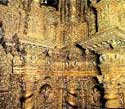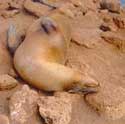Quito
And Galapagos Islands Cruise
11 Days / 10 Nights
Classic Quito and 7 nights aboard the M/V Coral I or II
Day 1 Friday
- Quito
Arrival In Quito. Upon arrival at the airport a host will meet
and assist you in transferring to the hotel and in registering.
Afternoon complimentary Quito scenic tour - Drive through this
overwhelmingly beautiful city down the broad avenues of the northern
residential section. See the modern Legislative Palace whose stone
murals record the country's history and the impressive San Agustin
Monastery and its Sala Capitular. Go downtown to Independence
Plaza, the town's oldest colonial center bordered by the Cathedral,
Government Palace, and Archbishop's Palace. Visit La Compañía
Church, famous for its ornate facade and glittering golden altars.
Visit San Francisco Church which is one of the first great religious
buildings in the New World and the home of the works of the famous
Indian artist, Caspicara.
Day 2 Saturday - Quito
Full Day Tour to Otavalo Indian Market - Early morning departure
for a drive along the Pan-American Highway to visit one of South
America's most famous Indian fairs, the Otavalo Market. En route
to the market, a quick stop at Calderón allows the opportunity
to see how the popular marzipan "bread dolls" are made
and to make "bargain price" purchases of them. Arriving
at Otavalo, take a walk through the bustling produce market where
the Indians meet to trade among themselves. Continue to the tourist
market, which is piled high with colorful ponchos, tapestries,
woolen goods, and Indian jewelry. In the afternoon drive to the
woodcarving center of San Antonio de Ibarra and to the village
of Cotacachi, famous for its leather handicrafts. Lunch is provided
en route.
Day 3 Sunday - Quito / Baltra Island / Santa Cruz Island
Transfer from hotel to the airport for departure.
Flight - Quito/Guayaquil/Baltra - The Galapagos Islands
Ship - M/V Coral I or II: 8 Days/7 Nights (Sunday-Sunday) cruising
the islands.
Welcome at Baltra Airport . Briefing on ship´s facilities at lounge
given by guides as well as National Park. Safety drill practice
with passengers, crew and guides.
In the afternoon visit the Highlands of Santa Cruz . Passengers
will observe the twin pit craters, Los Gemelos and later visit
Cerro Chato. The chances are good that another sighting of the
famous Giant Tortoises that gave the name to these islands will
occur. Additionally, travelers can literally get into the Galapagos
by walking in the dormant lava tubes.
Day 4 Monday - Española Island
AM: Española Island - Travelers enjoy a dry landing
at Suarez Point . Upon landing visitors will learn more about
the lava terrain while crossing the inactive lava fields.. Aside
from the Sea Lion colonies, this is one of the most important
sites for bird watching. As soon as visitors step foot on this
island many species can be spotted and observed up close. Among
the many species, the Hooded Mocking bird and Red Billed Tropic
Bird can be seen. Travelers will also spot a large colony of Marine
Iguanas, Lava Lizards, and the colorful Sally Light Foot Crabs.
After a short trek visitors encounter colonies of masked and blue-footed
boobies. Nesting grounds sometimes overlap the trail. Visitors
will also find Galapagos Doves, Hawks and Swallow-Tailed Gulls.
After crossing the nesting grounds you will reach the world's
largest colony of Waved Albatross (15000 approx.), Their mating
rituals are a highlight. Nearing the end of this excursion passengers
will visit the famous blowhole, where water shoots into the air
at almost 23 mts. (75 ft.).
PM: Gardner Bay wet landing on a white coral beach amidst a large
colony of Sea Lions. This site has no trails, therefore no hiking,
but is considered an open area where you can spot: Galapagos Hawks,
American Oyster Catchers, Galapagos Doves, Hood Mockingbirds,
3 species of Darwin Finches, Yellow Warblers, Lava Lizards and
Marine Iguanas and a great place for swimming and snorkeling,
the best spot is by the rock outcropping that looks like a turtle.
Often snorkelers see many of the Galapagos marine species such
as King Angelfish, Creole Fish, Damsel Fish, Parrot Fish, Manta
Rays, White Tipped Reef Sharks, and many more.
Day 5 Tuesday - Floreana Island / Plaza Island
AM: Floreana Island Cormorant Point - Wet landing on a greenish
colored sand beach. Passengers will hike a well marked trail beginning
in the Black Mangrove beds heading toward the back of the lagoon.
The large, brackish lagoon holds one of the biggest populations
of flamingos in the Galápagos. This island is best known for its
endemic plant life, such as the Galápagos millwork, Passion flower,
and unique button mangrove. Novice snorkelers can practice back
on the main beach where the sea lions are playful, while experienced
snorkelers can roam the waters around Devils Crown.
PM: Plaza Island - This is one of the two small islands located
from the East coast of Santa Cruz . Passengers will enjoy a view
of both North and South islands. Embarking only on the Southern
island, Plaza del Sure. Another great wet landing. Passengers
will hike the short trail observing endemic species of vegetation.
Despite its small size, some of the most interesting species are
here, such as Land Iguanas that are often hiding in the shade
of cacti, and the nesting areas for the swallow-tailed gulls.
The largest colony of Sea Lions in the Galapagos can be found
here.
Day 6 Wednesday - North Seymour Island / Baltra Island
AM: North Seymour Island - After a dry landing guests will
encounter Swallow Tailed Gulls and Sea Lions. This site is also
known for being a major nesting colony for Blue Footed Boobies,
and the largest colony of the Magnificent Frigate Bird. (a different
species from the Great Frigate Bird). Travelers will also spot
both endemic species of iguanas, the Marine Iguanas and Land Iguanas.
Passengers will enjoy this relaxed hike around the nesting sites.
PM: Baltra Island - Disembark at the docks, passengers board a
bus that drives them to the airport for their flight back to mainland
via Guayaquil to Quito .
Day 7 Thursday - Rabida Island / Santiago Island
AM: Rábida Island - Dry landing at the dark red colored beach
of volcanic origin, frequented by sea lions. It is often considered
the geographic center of Galapagos because it has the most diversified
volcanic rocks in all of the Islands . Here a short trail leads
to a salt water lagoon, where we find small colonies of Flamingos
feeding. The brown pelican nests in the mangroves found at the
far side of the lagoon. Also to be found are boobies and 9 species
of Darwin 's finches. Dinghie ride by the reefs and an excellent
opportunity for snorkeling.
PM: Santiago Island - Visit the dark sand beach at Puerto Egas
during a wet landing. Most of the landscape is tuff-stone layers
and lava flows, the surrounding area is prime for spotting and
observing Hunting Herons, Great Blue Herons, Lava Herons, Oyster
Catchers, and the Yellow Crowned Night Heron. Passengers enjoy
the sight of Marine Iguanas grazing upon algae beds at low tide
sharing space with Red Sally Light-Foot Crabs. There is a colony
of Fur-Seal swimming in deep pools of cool water called “grottos”.
This is an excellent spot for swimming and snorkeling in search
of Octopuses, Sea Horses, Star Fish and other sea life caught
in the small tidal pools. From a safe distance travelers can admire
Moray Eels, Hammerhead Sharks, White Tip and Galapagos Sharks,
Golden and White Spotted Eagle Rays, Jacks, Wahoo, Tuna, Groupers,
Red-Tailed and Dog Snappers, Sea Lions, and Sea Turtles. All located
in the back drop of cold water and warm water corals, fans, and
sponge.
Day 8 Friday - Fernandina Island / Isabela Island
AM: Fernandina Island - After a dry landing at Espinoza Point
, passengers will see the largest colony of Marine Iguanas mingling
with Sally-light Foot Crabs,. Also enjoyed are the Flightless
Cormorants nesting sites, the Galapagos Penguins, Galapagos Hawks,
and Sea lions. Among the flora and volcanic formations observers
will note Brachycereus Cactus, “pa-hoe-hoe” lava, and other unusual
lava formations. Travelers will view recent lava flows from a
safe distance. Also numerous mangrove beds extend into the sea,
depicting a healthy and thriving eco-system.
PM: Isabela Island - Vicente Roca Point , open for dinghy sightseeing,
snorkeling, and scuba. Travelers will enjoy high cliffs with tuff
stone, ash, and other lava formations. Caves and plenty of nesting
sites for Brown Noddies and Blue Footed Boobies. Up close encounters
with the occasional Dolphin, but Sea Lions and Fur Seals are often
reported.
Day 9 Saturday - Bartolome Island / Santa Cruz Island
AM: Bartolomé Island - Dry landing, passengers will see volcanic
formations including lava bombs, spatter, and cinder cones. After
a hike to the summit visitors have an impressive view of the surrounding
islands, including the eroded tuff cone of Pinnacle Rock. During
the ascent travelers will often see a large colony of Marine Iguanas
and Lava Lizards. Red Mangroves, Tiquilla, and various cacti all
add to the experience. Visitors also enjoy a chance to cool off
while snorkeling. Here travelers often see the Galapagos Penguin,
Sea Turtles, and White Tipped Sharks from a safe distance.
PM:
Santa Cruz Island - Black Turtle Cove located near Las Bachas
beach in the north of Santa Cruz Island . This excursion provides
passengers with a “panga” ride though the mangrove, during which
the outboard motor of the small boat is turned off. This allows
for the close observation of Sea Turtles, White Tipped Reef Sharks,
Spotted Eagle Rays, and Yellow Rays.
Day
10 Sunday - Santa Cruz Island / Baltra Island / Guayaquil / Quito
AM: Santa Cruz Island Charles Darwin Research Station in Puerto
Ayora, staffed with international scientists conducting biological
research and conservation projects. Here you can also admire Giant
Tortoises, part of the breeding program. Also travelers can admire
the impressive Giant Prickly-Pear Cactus forest and many land
birds. The visit to the station takes around 40 minutes. After
this visit passengers have some free time to walk around town
and shop for souvenirs.
PM: Baltra Island Baltra´s airport in order to take the flight
back to Guayaquil and then to Quito. Upon arrival at the airport
a host will meet and assist you in transferring to the hotel and
in registering.
Day 11 Monday - Quito / USA
Transfer from hotel to the airport for departure.
Flight - Quito / USA
***
End Of Our Services ***
Departures:
Every Friday.
Hotels to use: Hotel Alameda Real in Quito.
Prices available upon request.
The
roundtrip airfare from Quito to the Galapagos Islands is also
included.
Not included: $100 Galapagos Island National Park tax.
All our tour packages include: Please
click here












